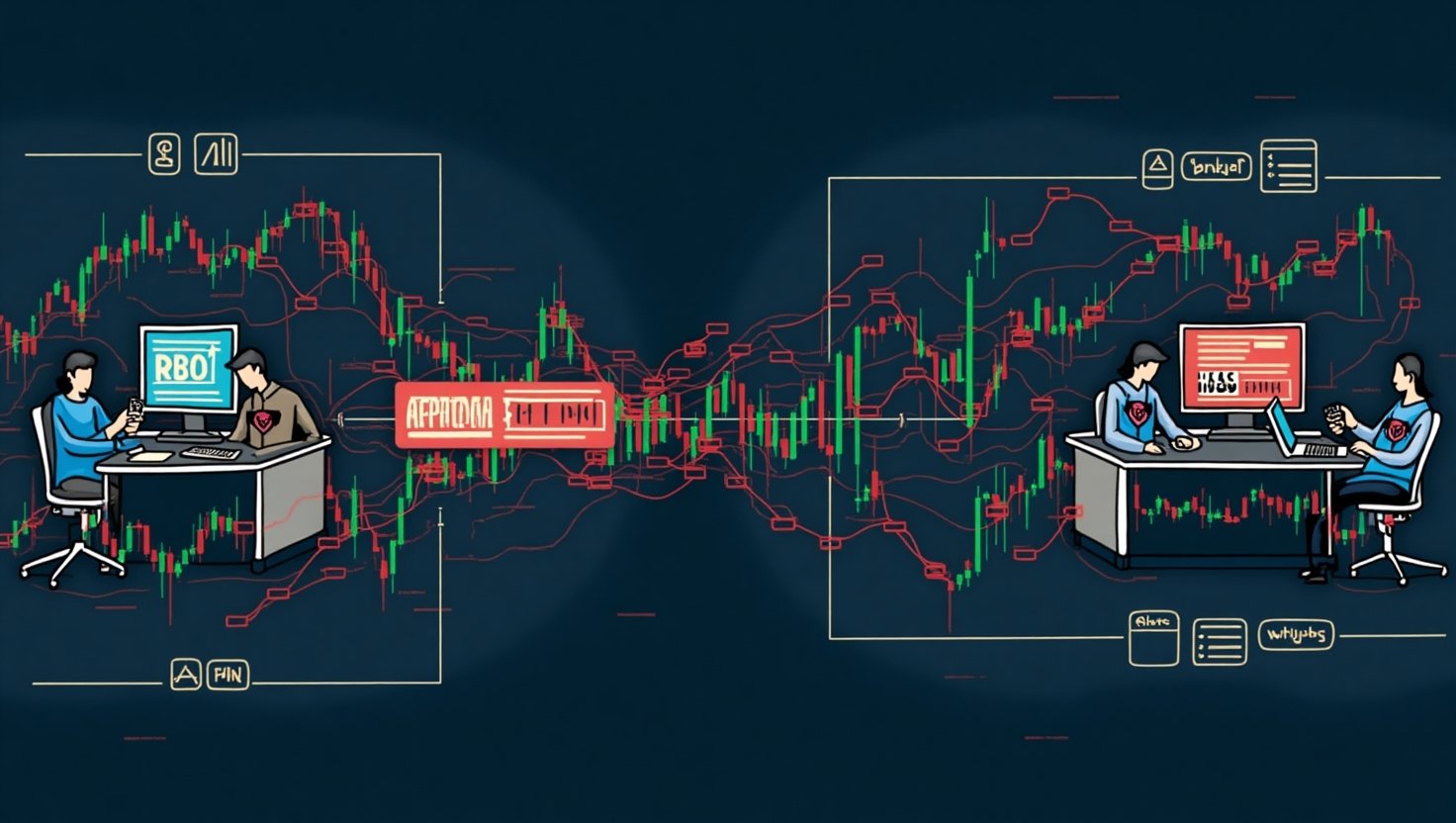In the fast-paced world of finance, few events have received as much attention and caused as much discussion as the 2010 Flash Crash. On May 6, 2010, markets experienced a sudden and severe drop, losing almost six percent of their value in just minutes. This event not only unsettled investors but also raised vital concerns about market stability—especially with the rise of rapid trading techniques and automated systems. Understanding the causes of flash crashes is crucial, as they highlight weaknesses in market structures and showcase the effects of quick trading technologies.
This is where agent-based modeling comes into play. By simulating interactions among different trading participants, this advanced method allows researchers to replicate and study complex market behaviors. As we explore how these market disruptions happen, agent-based models become a vital tool that can mimic the actions of individual traders and the overall market situation. Using these models, we can examine the factors leading to flash crashes, including market maker inventories and trading strategies. Grasping these elements is essential for reducing the chances of future crises and boosting market stability.
Overview of Agent-Based Modeling in Financial Markets
Agent-based modeling (ABM) is an advanced computational approach used to simulate the actions and interactions of autonomous agents in financial markets. This method offers a valuable framework for understanding complex market behaviors and dynamics, particularly during significant disruptions such as flash crashes. Its significance in financial analysis has been underscored by numerous studies and real-world applications.
Importance of Agent-Based Modeling
- Captures Trader Heterogeneity: ABM allows for a diverse representation of market participants, including different trading strategies and risk tolerances, leading to more realistic simulations of market fluctuations.
- Evaluates Market Dynamics: It aids in visualizing how various factors, such as trader behavior and market conditions, influence price patterns and volatility over time.
- Supports Policy Making: The insights gained from model simulations can guide policymakers and regulators in crafting rules that enhance market stability.
Flash Crash Analysis
Agent-based modeling has proven instrumental in analyzing events like the 2010 Flash Crash. Key aspects of its contribution include:
- Replicating Market Behaviors: Models calibrated through historical data demonstrate behaviors similar to those observed in actual crash scenarios. As noted, “The simulated dynamics are consistent with what happened in historical flash crash scenarios.”
- Understanding Influential Factors: Research has identified critical variables affecting flash crashes, such as, “The percentage of volume of the Sell Algorithm, the market maker inventory limit, and the trading frequency of fundamental traders significantly affect the amplitude of the Flash Crash.”
- Identifying Miniscule Crashes: Beyond singular events, ABM can uncover patterns, having identified over 18,000 mini flash crashes in the U.S. equity market from 2006 to 2011, indicating that market shocks can occur frequently on a smaller scale.
Conclusion
In conclusion, agent-based modeling serves as a promising tool in financial markets. Its capability to simulate complex interactions helps researchers unravel the intricacies of market humor, providing insights that can lead to more effective management strategies for mitigating risks associated with flash crashes. As a valuable technique, it highlights the necessity for continued innovations in modeling frameworks to adapt to evolving market landscapes.
| Flash Crash Event | Duration | Market Drop (%) | Volume Involved |
|---|---|---|---|
| 2010 Flash Crash | Approximately 36 Minutes | Nearly 9% | Sell order of 75,000 E-mini S&P 500 contracts ($4.1 billion) |
| Mini Flash Crashes | Less than 1.5 Seconds | Average -1.39% | Typically driven by a single market order |
Characteristics
- Approximately 12 occur daily in the U.S.
- Increased likelihood of large orders during crises
- Duration, drop percentage, and volume fluctuate
Causes and Impacts of the 2010 Flash Crash
The 2010 Flash Crash is a significant event in market history. It saw the Dow Jones Industrial Average plunge by nearly 9% in just minutes. Understanding why this crash occurred and its effects is vital for grasping the flaws in today’s financial markets.
Key Market Dynamics
A massive sell order was at the core of the flash crash, initiated by a large mutual fund. They sold 75,000 E-mini S&P 500 futures contracts, valued at about $4.1 billion, without regard to market prices or liquidity levels. This significant sell-off disrupted market liquidity and triggered a ripple effect throughout the financial system.
High-frequency trading (HFT) firms, which usually provide liquidity, began executing rapid trades among themselves, creating what’s known as the “hot-potato” effect. As the prices of these futures contracts dropped sharply, this instability spread to broader equity markets. Many stocks experienced drastic price changes, with some trading at mere pennies, while others surged to outrageous prices, such as $100,000.
Human Factors Involved
Automated trading systems played a crucial role during the flash crash. When market volatility escalated, many HFT firms pulled back from trading, creating a liquidity gap. In this situation, automated systems made trades based solely on their programmed rules, without any human intervention. Mary Schapiro, then-chair of the SEC, pointed out that “Automated trading systems will follow their coded logic regardless of outcome, while human involvement likely would have prevented these orders from executing at absurd prices.”
This reliance on automation highlighted vulnerabilities in the market structure. Gary Gensler, chair of the Commodity Futures Trading Commission, noted that “Algorithms don’t think smart. They are programmed to do what they do. Repeatedly,” stressing the risks tied to the increasing dependence on algorithmic trading.
Significant Outcomes and Lessons Learned
The immediate response to the flash crash was chaotic. Although the market eventually stabilized, the event caused extensive losses and heightened concerns about market regulation. Around $1 trillion vanished in seconds, revealing the susceptibility in automated trading systems.
Andy Haldane, an executive director for financial stability at the Bank of England, candidly remarked, “We do not need to await a second flash crash to establish it was no fluke.” His comment emphasizes the ongoing conversations among regulators about the necessity for reforms in trading practices to prevent future incidents.
In summary, the 2010 Flash Crash is an essential case study that reflects the relationship between automated trading systems and market dynamics. It underscores the need for human oversight in trading practices and advocates for robust regulatory frameworks to reduce risks related to extreme market volatility, ultimately promoting a more stable financial environment.

Summary of Findings from Studies on High-Frequency Models and Artificial Markets
Recent investigations into high-frequency trading (HFT) and agent-based modeling in financial markets have yielded significant insights, particularly concerning their effectiveness in predicting financial shifts and understanding market crashes. The following key findings synthesize the insights from various studies:
1. High-Frequency Trading’s Dual Role
High-frequency trading has been found to enhance market liquidity by increasing trading volumes and reducing bid-ask spreads. However, this same phenomenon has also contributed to increased market volatility. For instance, a study indicated that the synchronization of sell orders among HFTs can lead to abrupt market downturns, exemplifying how HFTs can inadvertently trigger flash crashes source.
2. Flash Crash Replication Using Agent-Based Models
Agent-based modeling has proven invaluable in analyzing flash crash events, particularly the notorious May 6, 2010, incident. One study developed a high-frequency agent-based simulator that could replicate the rapid price movements observed during the flash crash, validating that critical variables, such as the volume of sell trades by algorithms, substantially affect crash severity. This ability to model and test potential scenarios offers policy-makers insights into market dynamics and investor behavior source.
3. Machine Learning Enhancements
The incorporation of machine learning techniques has revolutionized the analysis of market stress features. A study demonstrated that machine learning models, notably random forests, outperformed traditional methods in predicting financial market stress, utilizing innovative indicators that capture liquidity issues and deviations from expected conditions source.
4. Challenges with Predictive Accuracy
Despite advances in AI and machine learning, studies highlight significant hurdles in accurately predicting market crashes. AI systems tend to struggle with unexpected, non-recurring events, indicating that human judgment still plays a crucial role in trading scenarios source.
5. Understanding Financial Contagion
Research also delved into contagion mechanisms within financial networks, illustrating how interconnected portfolios can propagate financial shocks. An agent-based model demonstrated that leverage through repurchase agreements could escalate distress across institutions, underscoring the systemic risks in modern financial infrastructures source.
Conclusion
The findings from these studies underscore the complex interplay between high-frequency trading, artificial markets, and predictive models in shaping our understanding of financial dynamics. Agent-based models, complemented by machine learning, offer robust frameworks for dissecting market behaviors and identifying potential risk factors. However, challenges remain, particularly in ensuring predictive accuracy and incorporating human oversight into automated trading practices. The ongoing evolution of these technologies will likely continue to influence financial stability and regulatory approaches in the future.
These insights are critical as they advance our understanding of financial markets and enhance strategies for preventing future market crashes, ensuring more resilient market structures.
Conclusion
Recent studies in financial markets underscore the growing intricacies associated with agent-based modeling and high-frequency trading (HFT). The exploration of these subjects provides valuable new insights, most notably about their implications for market stability during episodes of volatility such as flash crashes.
Recent advancements in agent-based modeling have introduced techniques like the Agent-Based Market Microstructure Simulation (ABMMS), which captures the complexities of market dynamics with adaptive agents and realistic mechanisms. This enhanced capability allows for a more accurate representation of trader behaviors under stress arxiv.org. Moreover, the development of scalable models, supporting parallel decision-making among agents, elevates our ability to analyze multi-asset financial environments and their statistical properties arxiv.org.
Furthermore, studies focusing on market responses during critical events like the 2010 Flash Crash reaffirm the importance of understanding algorithm-driven instability. These models have consistently illustrated how algorithmic trading triggers severe market reactions—shifting from liquidity provision to risk amplification—in times of strain arxiv.org. The evolving landscape of HFT, with firms like Citadel Securities leading in volume and market influence, reflects both enhanced trading efficiency and heightened regulatory scrutiny due to risks of market fragility ft.com.
Regulators are increasingly addressing these challenges by refining frameworks that enhance oversight of HFT activities. Notable initiatives include the SEC’s proposed amendments aimed at increasing oversight, which represent proactive steps towards safeguarding market integrity sec.gov. Ultimately, understanding these dynamics will be essential in ensuring resilient financial systems and mitigating risks associated with rapid trading technologies.
As we navigate the complexities of modern finance, the integration of robust agent-based models and continuous advancements in HFT will be imperative. Emphasizing effective regulatory measures will not only protect market stability but also foster an environment conducive to innovation and sustainable growth.
User Adoption and Practical Applications of Agent-Based Modeling
Agent-Based Modeling (ABM) has gained significant traction in financial markets, illustrating its relevance and effectiveness in understanding and simulating complex market dynamics. Financial institutions increasingly recognize the methodology’s potential for improving risk management practices and decision-making processes based on market simulations.
Recent Trends in User Adoption
Although specific statistics on user adoption rates are somewhat sparse, the growing interest in ABM is well-documented. A review by Axtell and Farmer (2025) outlined the expanding role of ABM in financial analysis, emphasizing its use in modeling market behavior and understanding systemic risks [source]. This indicates a shift as practitioners look for sophisticated tools to navigate the complexities of modern financial systems.
Practical Applications of ABM
Recent studies have showcased several practical applications of ABM in financial markets:
- Market Simulation and Stylized Facts: Research by Wheeler and Varner (2023) introduced a scalable ABM framework capable of simulating large-scale financial markets featuring multiple assets, effectively replicating inherent market statistical properties. This model operates independently of historical data fitting, demonstrating ABM’s adaptability [source].
- Behavioral Finance and Market Efficiency: A study by Zhou et al. (2023) leveraged ABM to assess the influence of financial literacy on stock market behavior. Enhanced investor knowledge was found to improve market quality and mitigate wealth inequality, underlining ABM’s utility for analyzing behavioral dynamics [source].
- Pricing Predictions: The work of Kanzari and Ben Said (2023) utilized a complex adaptive agent model to forecast stock prices by incorporating heterogeneous agent behaviors. Their findings underscore the capability of ABM to capture intricate market interactions and improve prediction accuracy [source].
In conclusion, the growing user adoption of ABM in financial markets highlights its importance as a tool for not only simulating market behaviors but also informing policy and improving market efficiency. The evidence from recent research demonstrates that ABM is a crucial asset in navigating the complexities of contemporary finance, making it an invaluable resource for industry stakeholders.

SEO Optimization Pointers for Market Volatility and Financial Regulation
To enhance the visibility and ranking of content focused on the 2010 Flash Crash and related topics in search engines, including aspects of market volatility and financial regulation, consider the following SEO optimization practices:
- Keyword Usage: Integrate main keywords such as 2010 Flash Crash, high-frequency trading, agent-based modeling, market stability strategies, and algorithmic trading risks throughout the content. Use variations in headings, subheadings, and body text to cover related keywords like mini flash crashes, market maker, and trading dynamics.
- Content Structure: Implement a clear and organized content structure using appropriate HTML header tags (H1, H2, H3) to enhance readability and help search engines understand the hierarchy of information. For example, ensure that sections discussing market volatility include relevant keywords to reinforce the main topic.
- Meta Descriptions: Craft compelling meta descriptions that accurately summarize the content while including target keywords. Make them between 150-160 characters and ensure they encourage clicks by being engaging and informative.
- Internal and External Links: Incorporate relevant internal links to other articles on your site discussing similar themes, such as previous studies on financial regulation or algorithmic trading. Additionally, link to reputable external sources, such as research or industry articles that can bolster your content’s credibility.
- Alt Text for Images: Use descriptive, keyword-rich alt text for all images to improve visibility in image searches and increase overall page relevance. For instance, in the context of flash crash dynamics, alt texts could include phrases like ‘Market Simulation Dynamics During Flash Crash’.
- Mobile Optimization: Ensure the content is mobile-responsive, as Google prioritizes mobile-friendly sites in its ranking algorithms. Test the layout and performance on various devices to provide a seamless user experience.
- Page Load Speed: Optimize images and reduce unnecessary scripts to improve page load times. Fast-loading pages provide a better user experience and can lead to higher rankings in search results.
- Use of Bullet Points: Break down complex information into bullet points or numbered lists to enhance readability and allow users to quickly scan for relevant information. This also makes it easier for search engines to index content.
- Social Sharing: Encourage social sharing by including social media buttons on the content pages. Engaging content that is shared can drive traffic and improve SEO rankings.
- Regular Updates: Keep the content fresh and relevant by updating it with new information, insights, or findings related to the subject matter, particularly regarding ongoing developments in AI, market volatility, and financial regulation.
By implementing these SEO practices, the content focusing on the 2010 Flash Crash and related topics can achieve higher rankings and attract a more substantial readership.
As we delve deeper into the specific causes and impacts of the 2010 Flash Crash, it is crucial to recognize how the insights gathered from agent-based modeling contribute to our understanding of market behaviors during such extreme events. By analyzing how various trading mechanisms interact under stress, we can better comprehend the vulnerabilities that led to the sudden market downturn. This will set the stage for a more detailed exploration of the critical dynamics and human factors involved in the flash crash, further illustrating the need for innovative solutions in modern financial markets.
As we delve deeper into the specific causes and impacts of the 2010 Flash Crash, it is crucial to recognize how the insights gathered from agent-based modeling contribute to our understanding of market behaviors during such extreme events. By analyzing how various trading mechanisms interact under stress, we can better comprehend the vulnerabilities that led to the sudden market downturn. This will set the stage for a more detailed exploration of the critical dynamics and human factors involved in the flash crash, further illustrating the need for innovative solutions in modern financial markets.

